Biodiversity and Conservation Notes
Biodiversity and Conservation are vital topics in the IB DP Environmental Systems and Societies (ESS) curriculum. This section explores the significance of biodiversity, the threats it faces, and effective conservation strategies. Students will examine ecological principles, the role of ecosystems in sustaining biodiversity, and the impacts of human activity. Mastering these concepts is essential for addressing global environmental challenges and fostering sustainable practices.
Biodiversity and Conservation
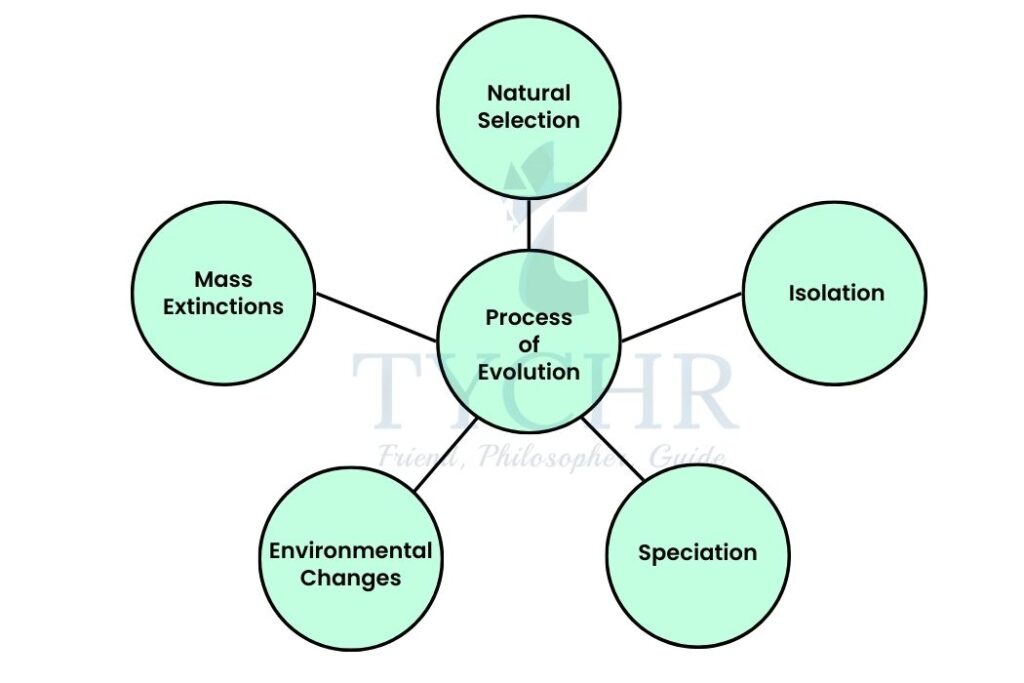
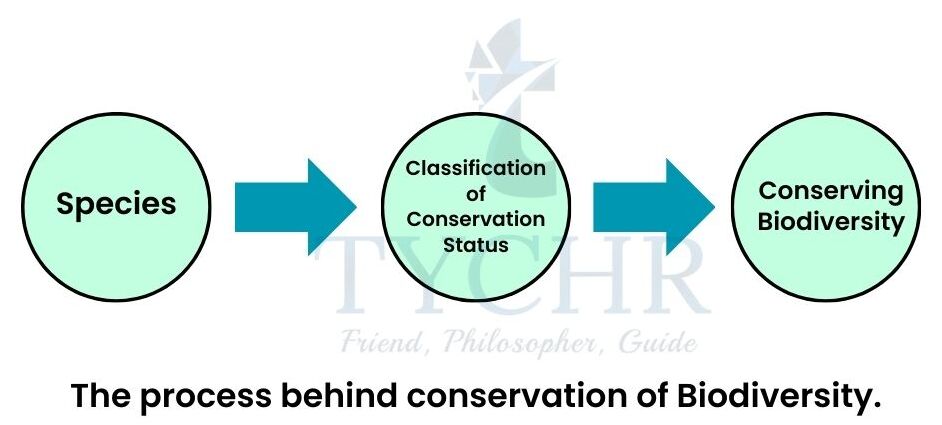
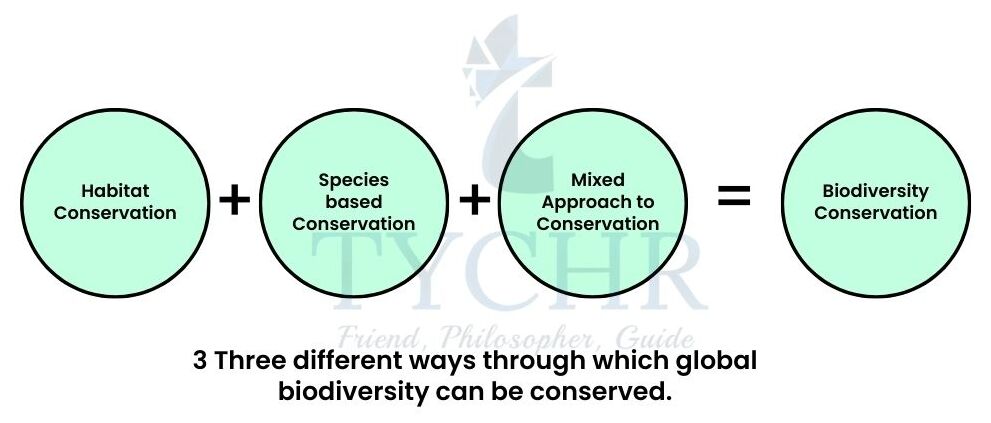
3.1 Introduction to Biodiversity
3.1.1 Biodiversity
The word “biodiversity” is derived from the term “biological diversity”. The concept includes habitat, species and genetic diversity:
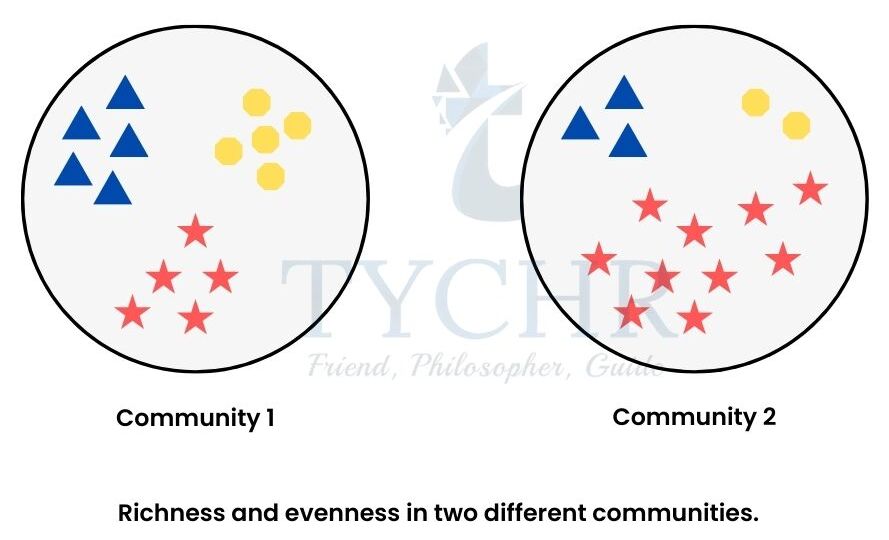
- Species Diversity- refers to the variety of species per unit area; it includes both the number of species present and their relative abundance. richness and evenness are components of biodiversity. Richness is a term that refers to the number of a species in an area, and evenness refers to the relative abundance of each species.
- Habitat Diversity- is often associated with the variety of ecological niches. Eg: a woodland has many habitats compared to a dessert.
- Genetic Diversity- A large gene pool leads to high genetic diversity and a small gene pool to low genetic diversity. However, the term regularly alludes to the variety inside one animal groups, it can likewise be utilised to allude to the variety of qualities in all species inside an area. Conservation of Biodiversity
3.1.2 Conservation of Biodiversity
Conservation means ‘keeping what we have’. The goal of conservation is to safeguard species and their habitats from human-caused disturbances like deforestation and pollution. Protection exercises plan to slow the pace of eradication brought about by the impacts of impractical abuse of regular assets and to keep up with biotic connections between species. Conservation biologists use Simpson’s index, a diversity index, to evaluate the impact of disturbance.
Quantification of biodiversity is crucial to conservation efforts because it enables the identification, exploration, and placement of appropriate conservation measures in areas with high biodiversity.
3.2 Origins of Biodiversity
3.2.1 How Biodiversity arises from Evolutionary Processes
The theory of evolution by natural selection was first developed by Charles Darwin. Because species show variation, those individuals that have adapted best to their surroundings (i.e. those that fit their environment) survive.
- Populations of a species show variation
- All species overproduce
- Even after over-production, the level of population remains the same.
- Overproduction leads to competition for resources
- The fittest, or best adapted organisms, survive
- The survivors reproduce and pass on their adaptive genes to the next generation
- The gene pool of the population changes over time, and new species emerge.
Speciation
The genetic makeup of a species changes over time through natural selection, which, when combined with isolation, can result in speciation. Subpopulations become genetically distinct to the point where they are unable to interbreed and are therefore distinct species if gene flow between them is prevented.
Isolation
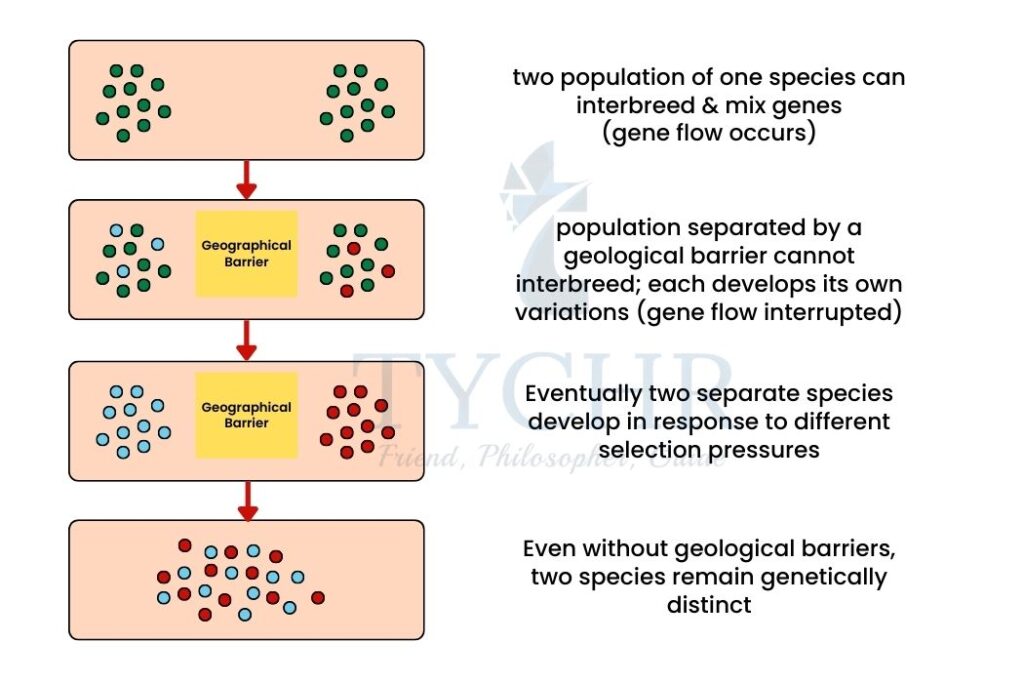
Isolation is essential to the process of speciation. Isolating mechanisms separate the populations so that natural selection can act separately on each population, leading to speciation. There are different types of isolation:
- Geographical isolation: As a result of island formation, loss of land bridges, mountains
- Behavioural differences: Different reproductive displays, songs, daily activity
- Anatomical differences: Reproductive organs, size.
Plate Boundary Types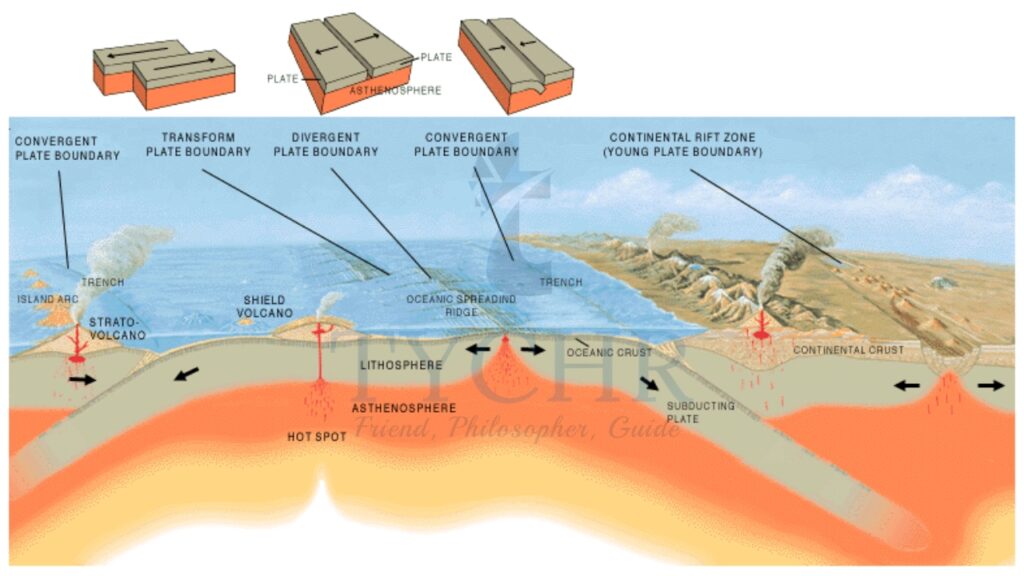
- Divergent Boundary- Constructive – new crust being formed
- Convergent Boundary- Destructive – crust being destroyed
- Transform Boundary- Conservative – friction is created
Continental- Continental Divergent Boundary | Oceanic-Continental Convergent Boundary | Oceanic-Oceanic Convergent Boundary | Continental-Continental Convergent Boundary |
|
|
|
|
3.2.3 Mass Extinctions
- A period where at least 75% of total species on Earth were wiped out at the same time. Species disappear in a geologically short time period due to abiotic phenomena.
- All mass extinctions have resulted in an increase in biodiversity – the large-scale loss of species left new opportunities for surviving populations to undergo adaptive radiation and fill different niches.
Ordovician – Silurian Extinction | Late Devonian Extinction | Permian – Triassic Extinction | End Triassic Extinction | Cretaceous Tertiary Extinction |
Impact: 439 million years ago, killed 86% of all species. Causes: drop in sea levels as glaciers formed; rise in sea levels as glaciers melted. | Impact: 364 million years ago, killed 75% of all species. Causes: global cooling followed by global warming. | Impact: 251 million years ago, killed 96% of all species. Causes: Flood volcanism that reduced sea oxygen. Tectonics and movement of Pangaea- which exposed isolated areas and organisms to increased competition. | Impact: 199 million years ago, killed 80% of all species. Causes: flood volcanism (lava) erupting from opening in the Atlantic, leading to climate change. | Impact: 65 million years ago, killed 76% of all species. Causes: Impact of the asteroid created a crater in the Gulf of Mexico – dust thrown into the atmosphere by impact could have reduced sunlight, limiting productivity and dropping temperature. |
3.3 Threats to Biodiversity
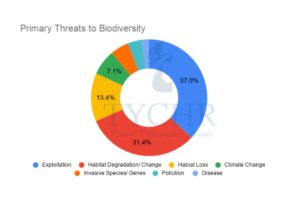
3.3.1 Species on Earth
Number of Species on Earth estimates vary considerably, as they are based on models and limited classification data. As a result, many habitats and groups are significantly under-recorded.
- Current consensus at 9 million species
- Most described species are larger organisms, mostly animals, easier to study
- Most diverse groups (insects, bacteria, fungi) are most difficult to study
- Of 1.8 million described species, 1% are vertebrates, yet they are the most studied
3.3.2 Rates of Species Loss
- 30,000 – 60,000 species a year, 100 – 100,000x greater than background extinction rate
- Existing species must be identified and named in order to understand extinction
- Humans contribute greatly to diversity loss, e.g. mammals 1 every 200 years should be lost, yet 90 species extinct in past 400 years.
3.3.3 Causes of Species Loss
- Natural Causes- Typically hazard events such as volcanoes, ice ages, drought
- Human Causes- Habitat destruction, invasive species, pollution, overharvesting, hunting all reduce diversity
- Habitat Destruction- Habitat degradation, fragmentation and loss
- Introduction of Invasive Species-Invasive species compete with endemic species, leading to extinction of native species
- Pollution- Chemicals, plastics, oil spills damage habitats and kill organisms.
- Agricultural Practices- Destroy native habitats and replace them with less diverse monocultures, non- specific pesticides often used in agriculture and wipe out both native and pest species. Plantation crops replace natural ecosystems.
- Mining Activities- Often destroy forests containing endangered species
- Overharvesting and Hunting – animals are hunted for food, medicines etc.
3.3.4 Threats to Tropical Biomes
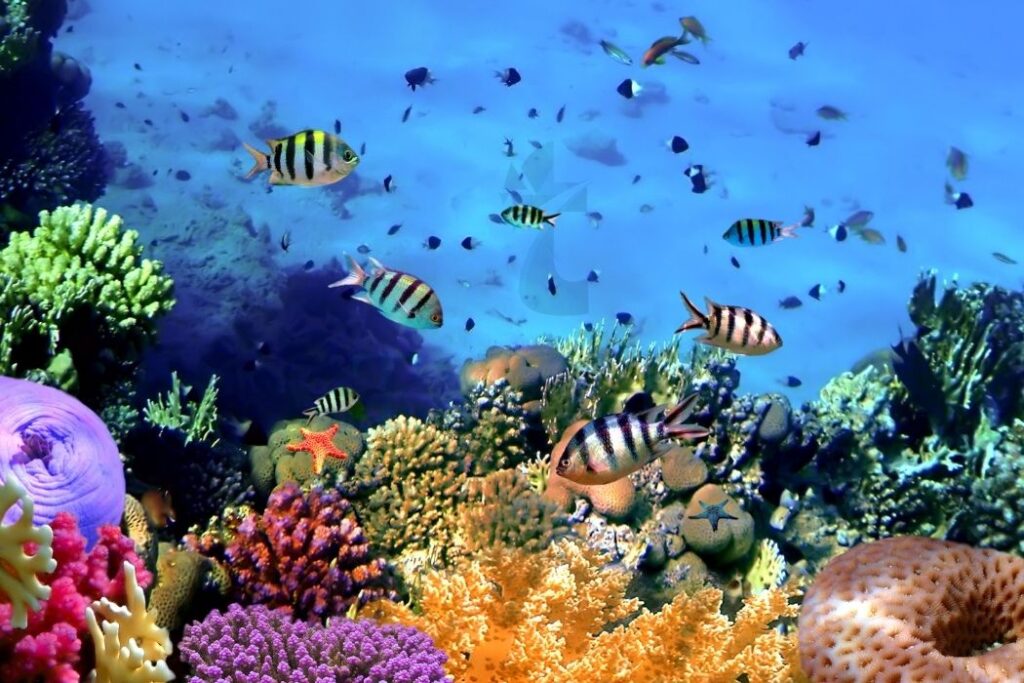
5.9% of earth’s land surface, some of the most globally biodiverse areas. Unsustainable exploitation of these areas results in loss of biodiversity and ability to perform ecological services. 1.5 ha of tropical rainforest is lost every 4 seconds- includes rainforests, coral reef, mangrove forests.
- Complex and warm structures, stable climates increase productivity and allow many niches to be supported.
- Perform crucial ecosystem functions- soil erosion prevention, controlling water cycle & weather, carbon sequestering etc.
Human Activity and Disturbance
- Deforestation and forest degradation driven by increasing demands for timber, beef, land for crops, and biofuels impact rainforests.
- Palm oil plantations replace a diverse climax community with a monoculture.
- Large timber removal means fast growing species block out light for slower K-strategists.
- The rate of loss of biodiversity varies depending on the ecosystems present, protection policies available, environmental viewpoints and stage of economic development.
3.3.5 Dispute Conservation, sustainable development and Exploitation.
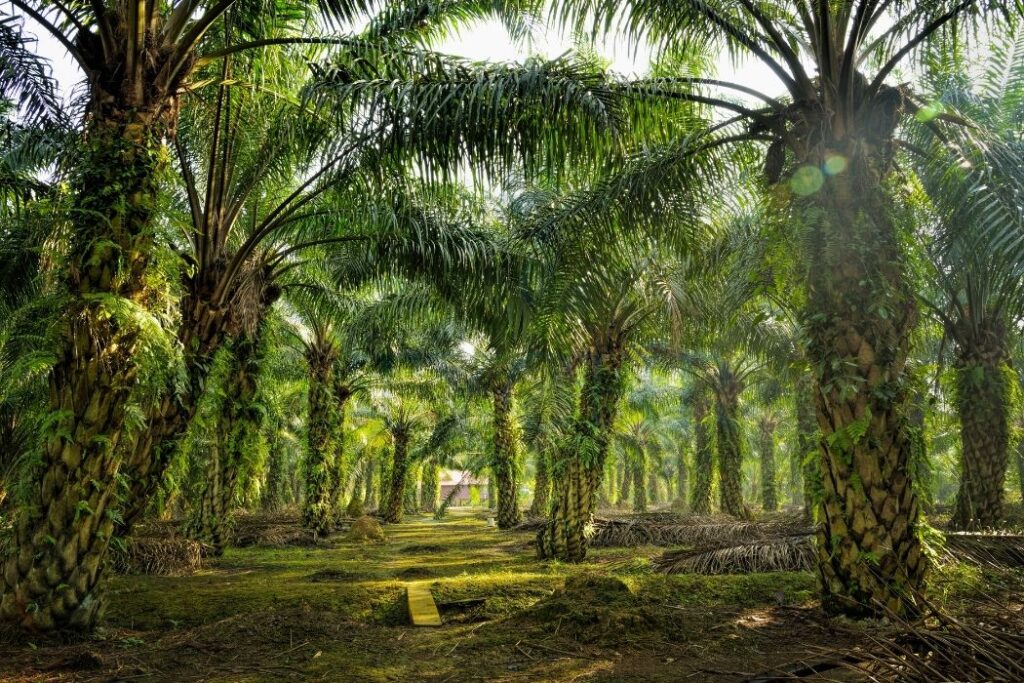
Due to their obligation to support local economies, LICs frequently engage in ecosystem exploitation; because they do not rely on ecosystems for income, HICs can preserve them.
- Arguments to preserve biodiversity are different in LICs, where most tropical biomes are found.
- For sustainable development to occur in LICs towards becoming MICs, balance between using land for income and conservation must be struck using local and governmental support.
3.3.6 Determining Conservation Status
The Red List
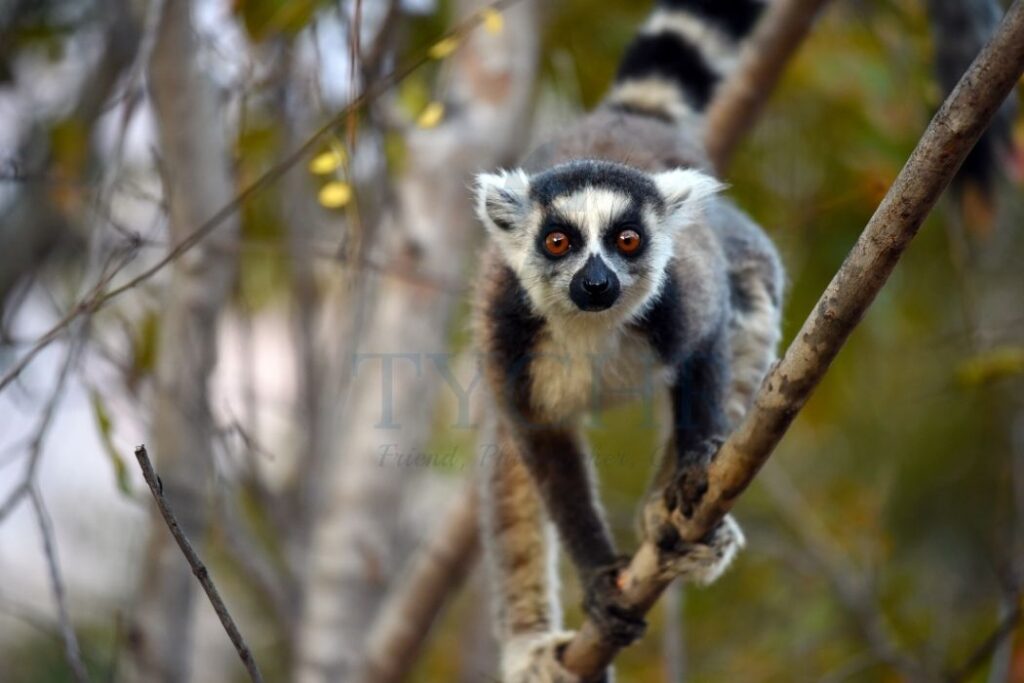
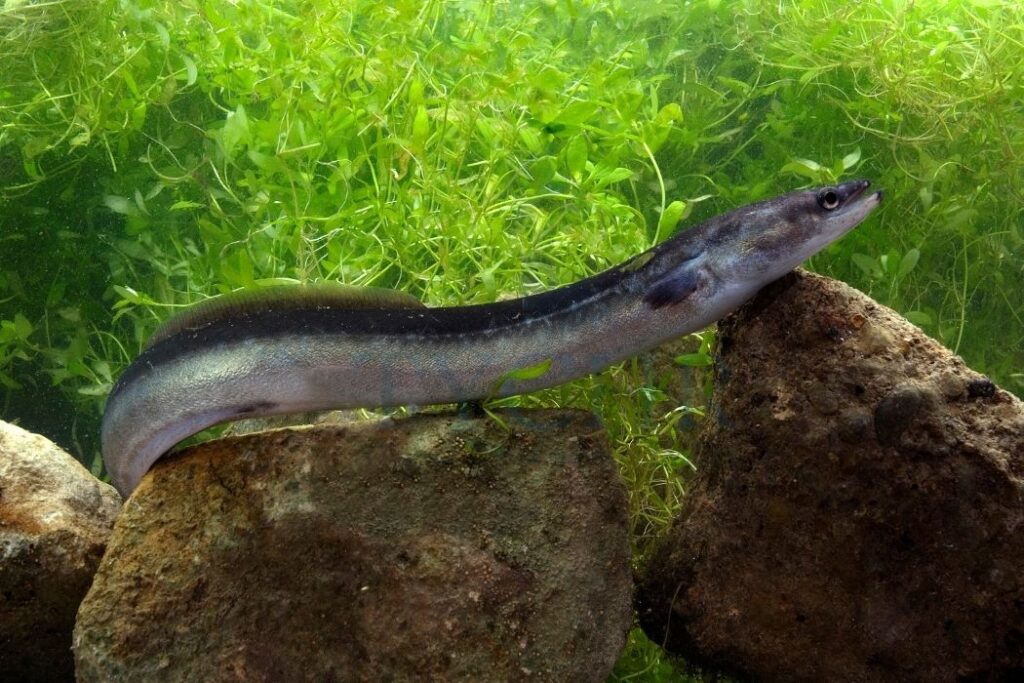
Published by IUCN (international Union of Conservation of Nature), seeking to conserve genetic diversity through awareness and providing a basis for conservation decisions at local and global levels.
- To identify species requiring conservation
- To identify species with conservation status concern
- To catalogue species facing a high risk of global extinction
3.4 Conservation of Biodiversity
3.4.1 Arguments for Conserving Biodiversity
Goods are easier to quantify than indirect values and services.
Aesthetic Reasons | Ecological Reasons | Economic Reasons | Ethical Reasons | Social Reasons |
Species/ habitats are pleasant to look at. | Habitats with endemic species must be preserved. Higher biodiversity = more resilience & stability = continued ecosystem services in future. Species extinctions have knock-on effects throughout food webs. | Value of ecotourism, genetic resources & commercial considerations of capital. Genetic diversity can allow improvements in crops etc. to be made – a genetic resource. Commercial resources (capital as medicines etc. or successful tourism) | Intrinsic value of a species – all have a right to survive, responsibility to protect for future | Ecosystems provide homes, livelihoods and cultural cohesion for indigenous people. |
3.4.2 Conservation Organisations
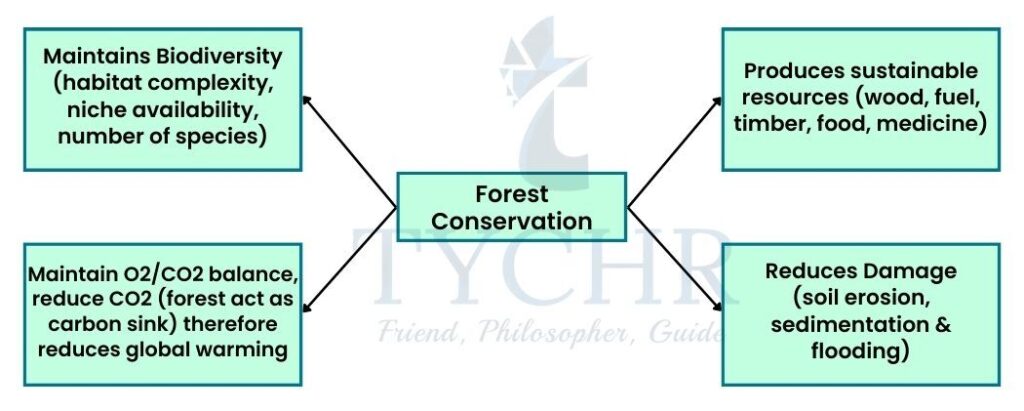
it can be international, governmental or non-governmental, and their use of the media, speed of response, diplomatic constraints, finances, and influence all play a role in how successful they are at conservation.
NGOs | IGOs | |
|
| |
Use of | Gain coverage through protests & campaigns | Cooperates with media to effectively communicate |
Media | (charismatic species), putting pressure on governments. | policies and decisions to the public. |
Speed of Response | Fast, members already at consensus regarding course of action. | Slow (bureaucratic), decisions directed by governments & require consensus. |
Agenda | Using public pressure and lobbying to influence government policies and legislation. | Provides guidelines and implementing international conservation treaties. |
Funding | From private donations. | Budget from national economies. |
Political Pressures | Environment focused, working towards idealistic conservation strategies. | Can be politically/economically driven rather than environmental. |
| ||
3.4.3 International Conventions on Biodiversity
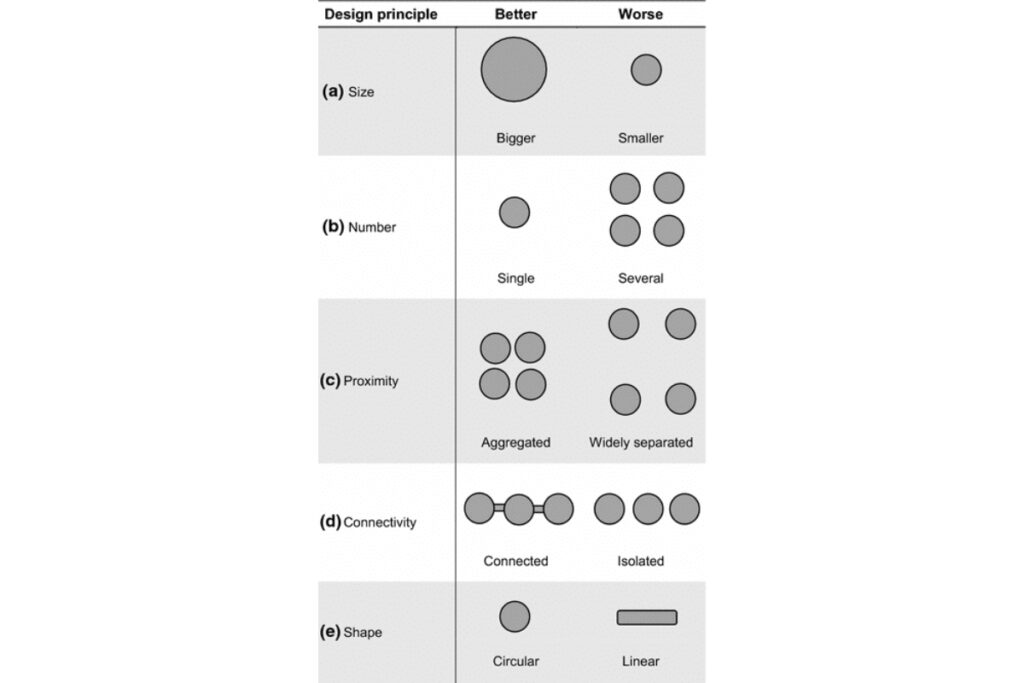
Conventions aim to create collaboration between nations for biodiversity conservation. IUCN (International Union for Conservation of Nature)
- Founded in 1948, concerned with importance of conservation of resources for sustainable development.
- Established Red List and World Conservation Strategy with the UNEP and WWF
In Situ Conservation
- The conservation of species in their
natural habitat. - Endangered animals & their
habitats are protected, conserving many
other species.
Ex Situ Conservation
- The preservation of species outside
their natural habitat. - Takes place in botanical gardens,
zoos, with captive breeding programmes. - It focuses on vulnerable species.
- Aims to attract interest & public pressure in conservation.
- Requires more funding.
3.4.4 Designing Protected Areas
Buffers to human influence, area, edge effects, shape, corridors must be considered (BAESC)
Buffer Zones- Successful areas are surrounded by buffers to minimise disturbances from outside influence
Area | Edge Effects | Shape | Corridors |
|
|
|
|
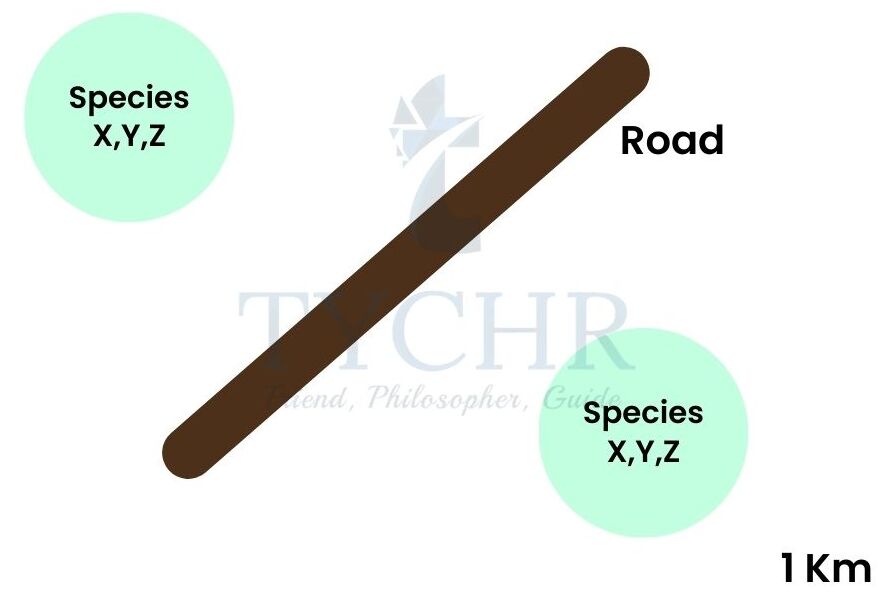
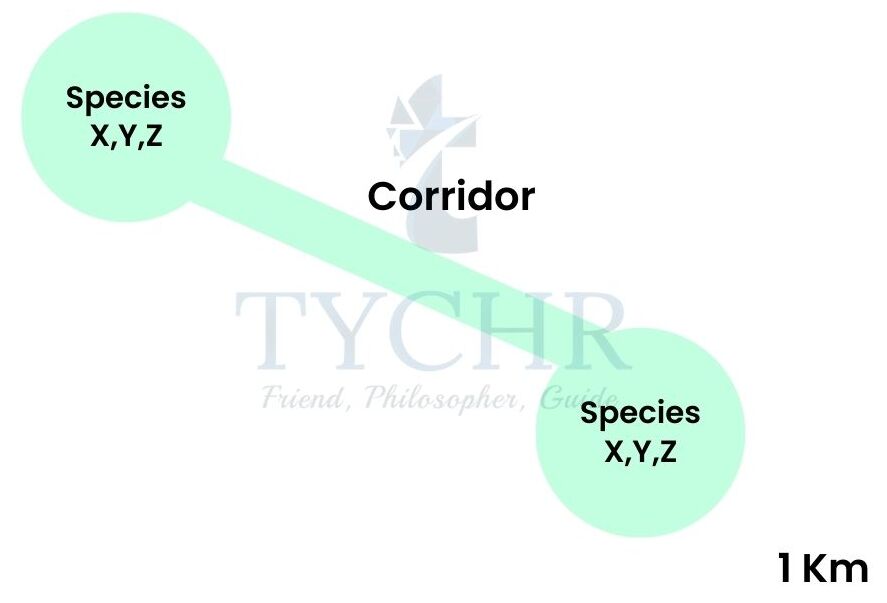
3.4.5 Species Based Conservation
CITES (Convention On International Trade in Endangered Species) Established in 1973, int’l agreement regulating trade in endangered species aimed at preventing trade in endangered species of plants and animals. While trade in plants & animals is worth billions, it reduces wild populations & exhausts species.
Evaluating a Protected Area
Strengths | Limitations |
|
|
Captive Breeding & Reintroduction Programmes (Zoos)
International zoos have focused for a long time on keeping endangered or critically endangered animals in order to shield them from threats in the wild. With the goal of reintroducing animals to the wild once their natural habitats have been protected, captive breeding programs maintain population numbers and genetic diversity.
Advantages | Disadvantages |
|
|
Flagship Species
Flagship species are “charismatic” species that help protect others in an area. They have a wide appeal to the public, and conserving these species will result in habitat protection that will also protect other species.
Keystone Species
A keystone species is a plant or animal that plays a central role in the way an ecosystem functions. Loss of a keystone species can lead to a significantly different ecosystem or the collapse of the ecosystem altogether. Conservation of keystone species helps to protect the integrity of food webs.
Mixed Approach
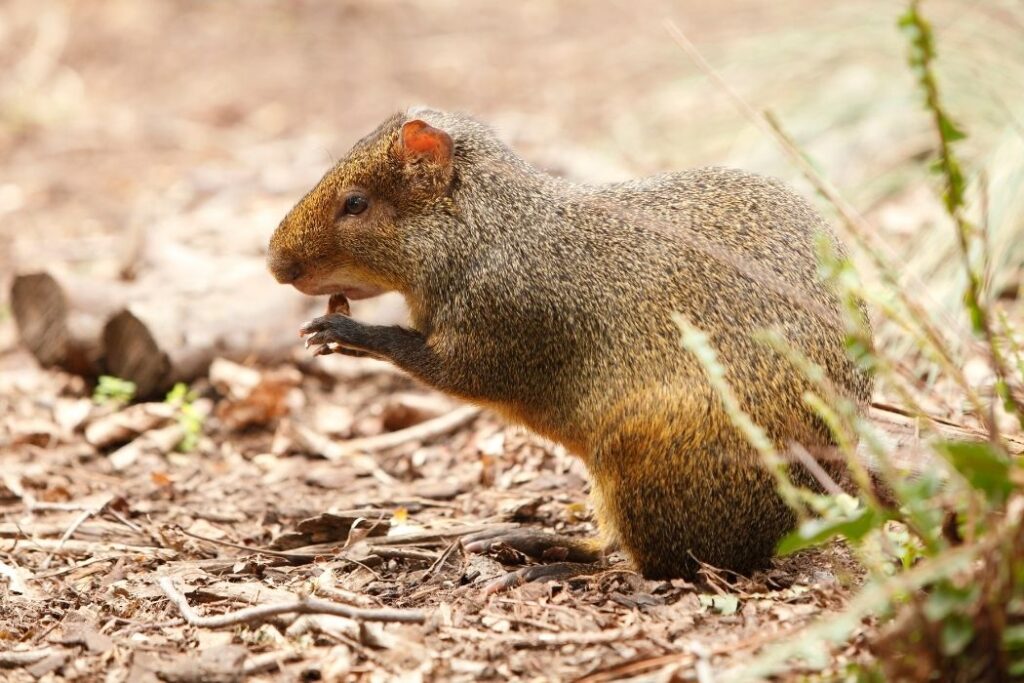
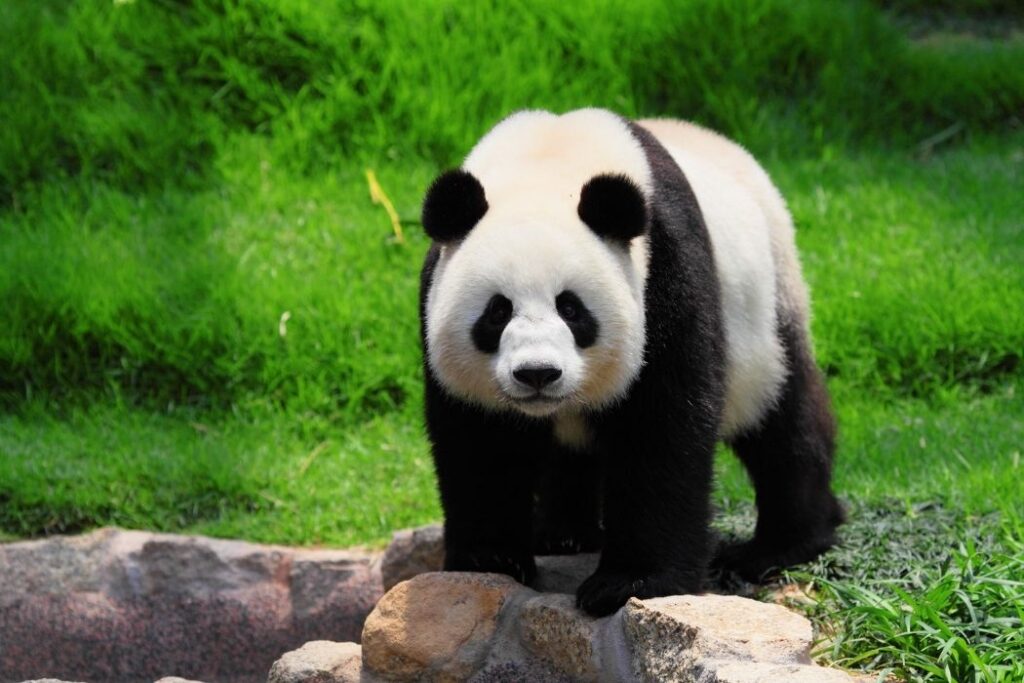
A mixed approach to conservation combines in situ and ex situ conservation as a means of successfully protecting and prolonging the lives of endangered and critically endangered animals.
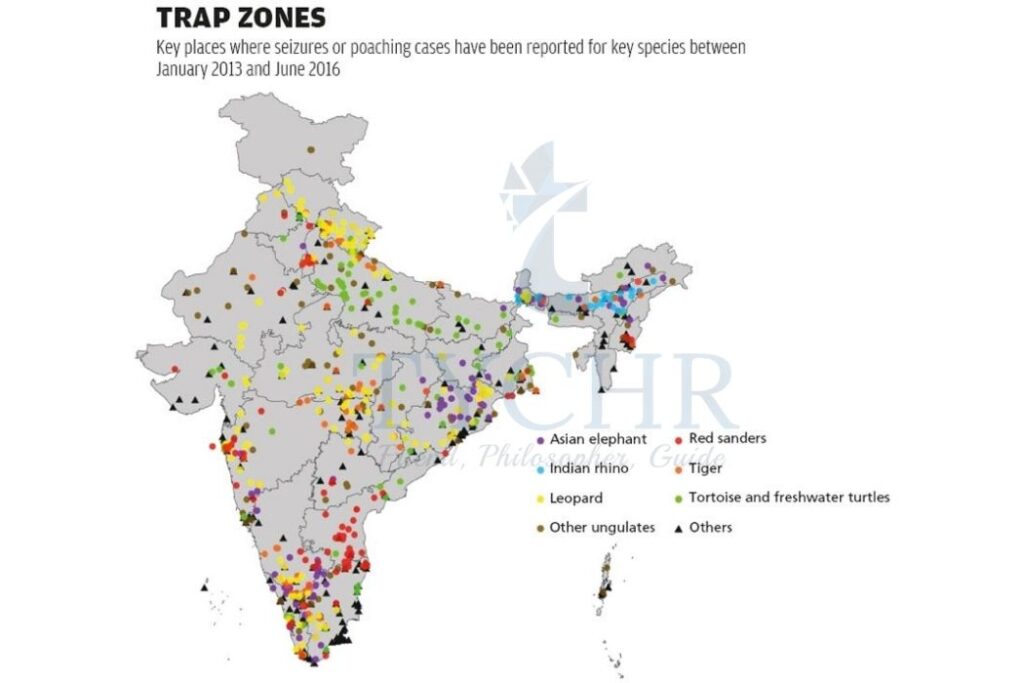
In conclusion, studying Biodiversity and Conservation in IB DP ESS provides students with a deeper understanding of the intricate relationships within ecosystems and the need for biodiversity preservation. It highlights the importance of adopting sustainable conservation methods to reduce the negative effects of human activities. For personalized support and expert guidance, students can turn to Tychr, where experienced IBDP ESS tutors can help enhance understanding and improve performance in this crucial area of study.

